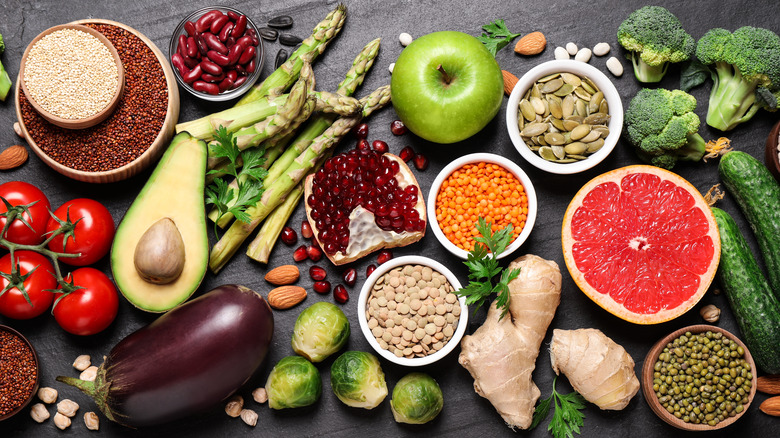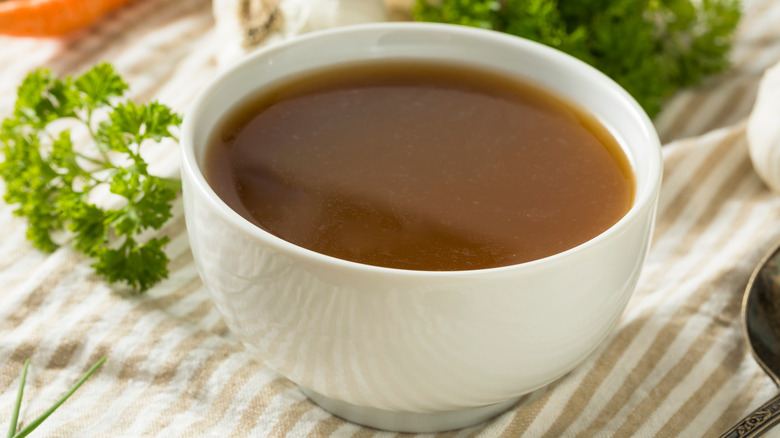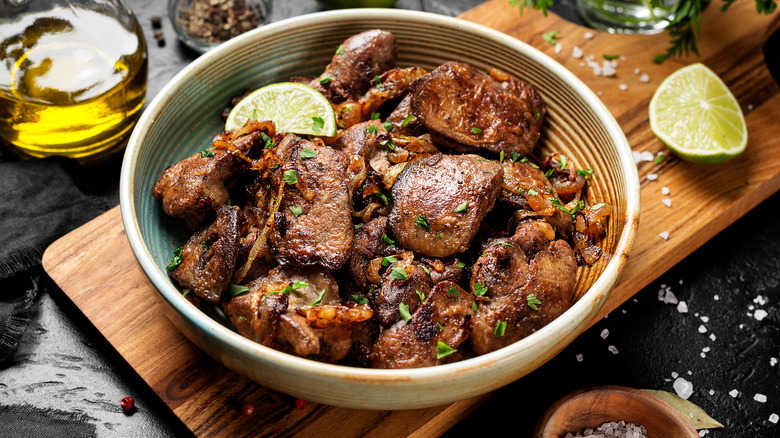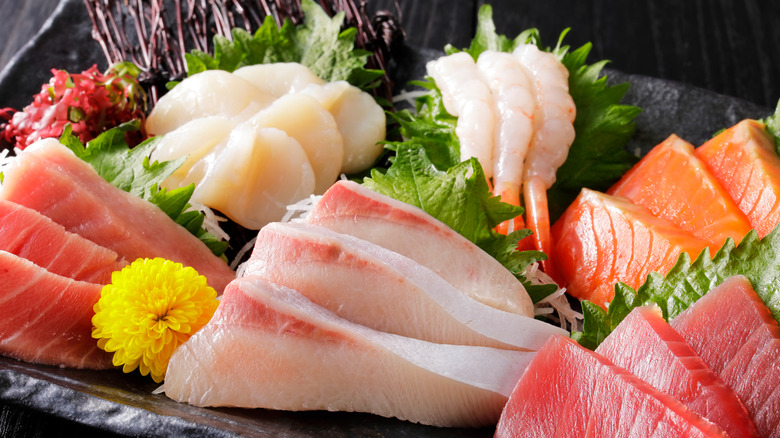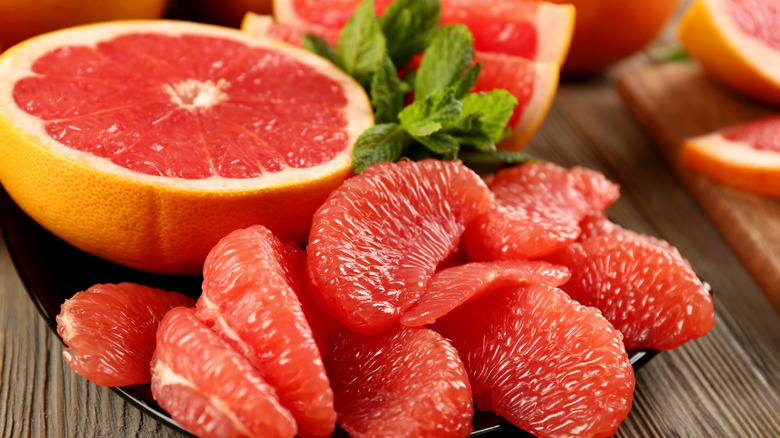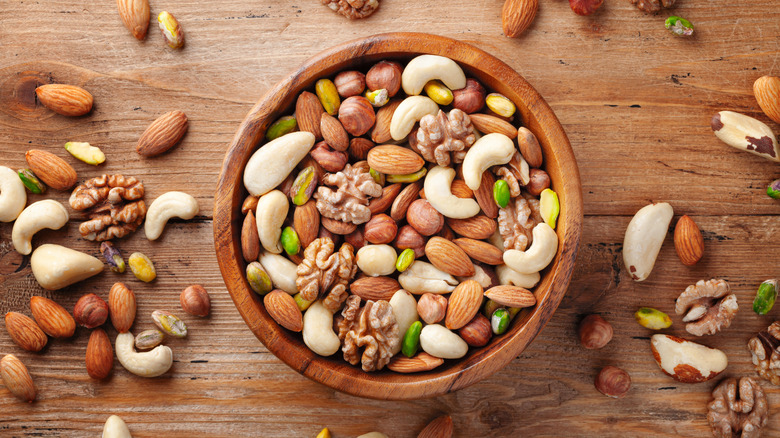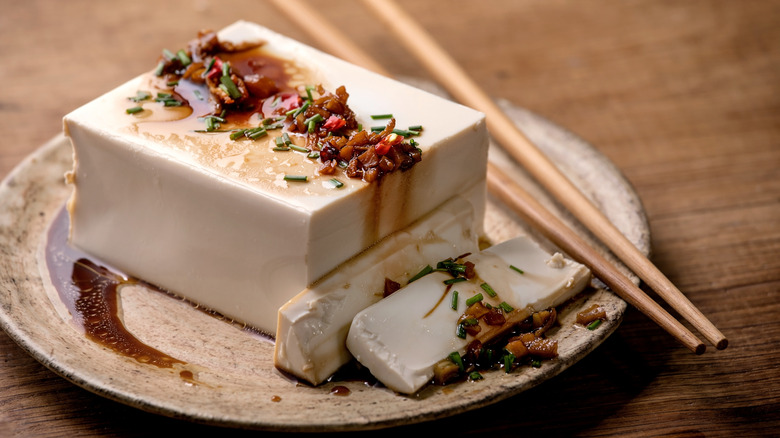Foods With Hyaluronic Acid That Can Improve Your Skin From The Inside Out
Hyaluronic acid is not only beneficial to your overall health but also tremendously useful as a supplement and topical agent for your skin. Hyaluronic acid is a jelly-like compound produced by your body that hydrates and lubricates the tissues of your eyes, joints, and skin. The medical journal Clinical Interventions in Aging ven emphasizes its broad potential for aesthetic use. In fact, hyaluronic acid is the main ingredient in fillers such as Juvederm and Restylane. Hyaluronic acid is also a popular ingredient in skincare serums and creams, as it locks in moisture due to its humectant properties.
Like collagen, the amount of hyaluronic acid your body produces decreases with age. Researchers have shown that over time, it can disappear from the epidermis, or outer layer, of your skin (via Dermato Endocrinology). While topical and injectable forms of hyaluronic acid are both great for improving the appearance of your skin, there is another way you can get more of this wonder substance.
There's no shortage of dietary supplements that support appearances, from hair and skin vitamins to collagen and hyaluronic acid-infused protein powders. However, the best way to absorb and encourage the production of supplemental nutrients is through foods, according to PeerJ research. Supporting your body's ability to create hyaluronic acid is possible. Now, here are six foods that can help you.
Bone broth
Researchers have studied the extraction of hyaluronic acid from animal products for decades. In fact, biochemist Karl Meyer was the first to identify hyaluronic acid in 1934 after deriving the substance from a cow's eye (via Annales de Chirurgie Plastique Esthetique). Then, a 1977 study from The Journal of Biological Chemistry described how hyaluronic acid was isolated from the nasal bones of cattle.
Even if you can't source cow's eyes or septums at your local grocery store, you should be able to find stew bones in the meat department or by asking your butcher. Your choices in bone broth are as varied as you'd like; for instance, you can utilize the bones left over from a rotisserie chicken or Thanksgiving turkey for a simple soup from scratch. And for those of us who aren't the cooking type, luckily, there are numerous prepared bone broth products currently on the market. Kettle and Fire, for example, is a slow-simmered bone broth producer with ready-made options carried at major retailers such as Target.
While there are certainly proponents who believe in bone broth's ability to heal everything from gut issues to joint pain, experts remain divided on its alleged effects. On this, registered dietitian Keri Gans explained to Parade, "The potential benefits may lie from the collagen in the broth, but it is uncertain if you are consuming a large enough amount from the broth to reap the health benefits."
Organ meats
Organ meats aren't always easy to find, but they're a fantastic source of hyaluronic acid, collagen, and high levels of other nutrients such as vitamin A. Although offal isn't as prevalent in the Western diet as it once was, there are still fiercely loyal fans of the underutilized cuts. Just look at TikTok star @theliverking, who is known to consume an entire pound of raw liver in one day. Although his diet is certainly tempting, there are plenty of other ways to work offal into your menu plan.
Some popular foods derived from organs include liver pâté, steak and kidney pie, haggis, and stewed oxtail. You may be delighted (or disgusted) to learn that pork rinds are also considered organ meat. Despite rising food prices in recent years, most organ meats are still relatively affordable when compared to muscle. If you're having trouble getting used to incorporating these off-cuts into your diet, look no further than British chef Fergus Henderson's classic cookbook, "The Whole Beast: Nose to Tail Eating," which is a helpful primer for learning to prepare organ meat.
Another benefit of consuming offal is that it may even help the planet. A study published in Environmental Science and Technology suggests that the consumption of organ meats could reduce greenhouse gas emissions from the meat industry by as much as 14%.
Seafood
According to research published in the medical journal Marine Drugs, fish can be an excellent source of hyaluronic acid, omega-3 fatty acids, and collagen. Some fish, such as mackerel and trout, are also high in DHA and EPA, two nutrients that support brain, eye, and heart health (via Oregon State University). And to top it off, seafood like shrimp, crab, lobster, and salmon contain an antioxidant known as astaxanthin, which researchers from Oxidative Medicine and Cellular Longevity have suggested could prevent the effects of aging.
There are a variety of affordable ways to get more seafood into your diet, starting with the use of canned fish, such as tuna or sardines, in salads. Frozen fish is often much cheaper than fresh, but you can also look for sales in the seafood department of your favorite market on easy-to-bake fish like salmon, haddock, and cod. If you're not keen on fishy flavors, you can try swordfish, tilapia, and arctic char, which are noted for their milder flavor profiles (via Cooking Light).
Citrus and tomatoes
While citrus fruits and tomatoes aren't inherently high in hyaluronic acid, they contain an enzyme called naringenin. Naringenin is a flavonoid that can inhibit the breakdown of hyaluronic acid, according to research from Food Science and Biotechnology. Studies are still being conducted to assess the relationship between naringenin and hyaluronic acid activity in the body, but there are many other good reasons to consume citrus fruits and tomatoes.
Citrus fruits and tomatoes are high in vitamin C, which helps to formulate collagen in your body. Vitamin C works to protect two important enzymes that are needed for the production of collagen (via the International Journal of Cosmetic Science). Though vitamin C is also known as a popular ingredient in topical skincare products, it's important to ingest it regularly in your diet to encourage healthy collagen synthesis. Another bonus in consuming tomatoes and citrus fruits is that both foods are loaded with antioxidants. Tomatoes contain lycopene, a powerful antioxidant linked to the lowered risk of cancer and heart disease, according to research published by the Canadian Medical Association Journal.
Citrus fruits contain a variety of potent antioxidants, including polyphenols, limonoids, and flavonoids such as quercetin. Quercetin has been studied for its potential effects on ailments such as allergies, heart disease, and even interstitial cystitis (via Mount Sinai). What's more, the journal Food Chemistry revealed that pomelo can contain up to 24 milligrams of quercetin per 100 grams of fruit.
Nuts and seeds
One factor that can impair your body's levels of hyaluronic acid is a deficiency in zinc or magnesium, according to research published in the Journal of Cellular Physiology. Fortunately, nuts and seeds are rich in both zinc and magnesium in addition to being an easily transportable snack. Zinc and magnesium are both essential minerals that support nerve, heart, and brain health.
Data published by the U.S. Department of Agriculture depicted pumpkin seeds as one of the best sources of zinc, delivering nearly eight milligrams for a 100-gram serving. A study in the Journal of Food Science and Technology showed that cashews and brazil nuts were relatively high in zinc, at about three milligrams per 100 grams of nuts. For reference, the recommended daily amount (RDA) of zinc is between eight to 11 milligrams for adults (via the Mayo Clinic). However, it's important to remember that your body will only utilize between 20 and 40% of the zinc found in food, according to research from Mount Sinai.
Even though the body needs magnesium to function properly, the Washington Post reports that a significant portion of the population is low in the mineral. You can counteract this by incorporating magnesium-rich nuts and seeds in your diet, like pumpkin seeds. An ounce of pumpkin seed kernels, for example, contains 168 milligrams of magnesium (via the Cleveland Clinic). Based on data provided by Harvard College, the RDA of magnesium for most adults is between 310 and 420 milligrams.
Soybeans
Soy plays a part in maintaining healthy hyaluronic acid levels in the body, although the versatile bean isn't rich in hyaluronate itself. Soybeans and soy-based products have naturally occurring levels of plant estrogens, and estrogen is known to help facilitate the production of hyaluronic acid in the body. Phytoestrogens are not only helpful for the formation of hyaluronic acid but also increase collagen stores and display antioxidant activity, according to a study published in Phytotherapy Research. Although there isn't a definitive guideline on the recommended intake of soy protein per day, studies suggest that up to 50 grams of soy protein per day are considered tolerable by most people (via the University of California, Davis).
You don't have to be vegan or vegetarian to enjoy soy – plenty of delicious meat alternatives and recipes feature soy as the star ingredient, from hiyayakko to mapo tofu. If you're not fond of the texture, you can use blended tofu in desserts or entrees or try soy milk or creamer in coffee.
